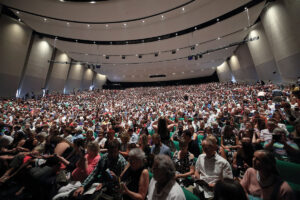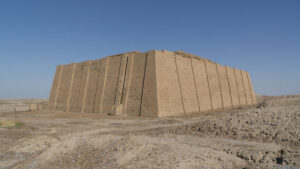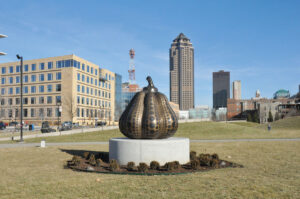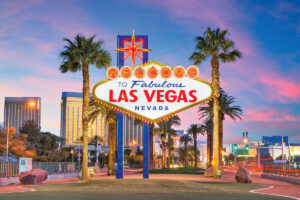The seating divide
1/6/2021
The Greater Des Moines Civic Center, which opened in 1979, resisted the tide of elitist designs in performing arts venues.
For three consecutive years in the 1970s, four German friends synchronized their vacations to tour America. They would fly into New York City, rent a car and drive to Las Vegas. The only overnight stop would be at my place, usually in the middle of the country. Otherwise, they took turns sleeping and driving until they reached their jackpot.
“The great thing about Las Vegas, and America in general, is its democracy. Anyone can play at any table, if he has the money. In Europe there are dress codes, private rooms, invitation-only tables. They are designed to keep out riff raff like us, no matter how much money we
have. Most casinos in America have all their games on one open floor. Entertainment should be democratic. No one wants to be made to feel crappy when they are spending their money,” they explained.
In the ensuing years, America became more like Europe. Vegas began tracking players and rewarding them with perks not available to those who gambled at a slower pace. Rewards included access to VIP clubs and tables. Sports arenas that used to segregate (outside the South) solely on the basis of proximity to the field of play began tearing perfectly good buildings down to replace them with new elitist structures designed to maximize income that was exempt from league revenue sharing rules.
The original sky boxes were built in Houston’s Astrodome and Dallas’ Texas Stadium. They were named because they were situated on the top of the seating, far from the action. Arena managers quickly realized that putting the luxury boxes in the middle, between the lower bowl and first upper deck, made them far more valuable. That turned fans into haves and have-nots, and they felt it.

The ziggurat of Ur is one of the first instances of architecture based on bricks rather than stones. That made staircases possible, and they were clearly elitist as they were used to escape rising flood waters. Guess who got the highest ground?
In the late 1970s, I lived in Georgia and attended basketball games at the University of Georgia Coliseum. Built in the early 1960s, the place still looked and felt like segregation, with bleachers only in the worst seats that once would have been reserved for Blacks only. By the late 1970s, no one sat in them. They are gone now, and so is the name Georgia Coliseum.
Does design affect the way people feel about attending events? How many people are priced out of attending shows and games because they don’t want to be made to feel crappy? Iowa is a great place to look for answers. We have a good sampling of democratically designed arenas like the Des Moines Civic Center, the Mcleod Center in Cedar Falls and Carver Hawkeye Arena plus elitist ones like Wells Fargo Arena and CY Stephens Auditorium.
Democratic and elitist
What do the terms democratic and elitist mean in public architecture? Surprisingly these contrasting styles have been around since the mythical architect of the universe Viśhwákarma laid plans in the Rigveda. Even before architecture, which began around 10,000 BC, there were opposing designs that were covered in democratic and elitist aromas. This likely began when humans moved from trees and campgrounds into caves. Who got in before the cave was closed off at night? That was the first VIP wrist stamp.
The original public buildings were the ziggurats of Sumer and pyramids of Egypt, both dating back 4,000 years. The Tower of Babel, the ziggurat mentioned in Genesis, dates back even further. The ziggurat of Ur is the oldest still standing and is still open to the public. It was one of the first instances of architecture based on bricks rather than stones. That made staircases possible, and they were clearly elitist as they were used to escape rising flood waters. Guess who got the highest ground?

The Pappajohn Sculpture Park downtown is free, something seldomly seen in the genre. It is so popular that real estate surrounding it has aggrandized in value more than 10 times since it opened in 2009.
Bricks also made it feasible to build structures up from rectangles, not just circles. Yet most public arenas remained bowl shaped for millennia, from the Roman Coliseum to the Lincoln High School Round House in Des Moines. Round arenas are democratic, even when they include imperial boxes and “bread and circus” sections for plebeians. The Coliseum games would be the only time that the patricians would be part of greater Rome. Then the rich would go home to their marble villas and the plebes to their dirt-floor mud huts.
For 2,000 years now, Europe’s most consistently democratic public architecture has been its churches. For 200 years, its most elitist public architecture has been its opera houses. That was intentional. Church was about being all-inclusive. Rich or poor, heaven or hell awaited. Opera houses were designed for the kind of stratification that turned off my old German pals. Probably the most flamboyant example of elitism in concert hall design is the Philharmonie de Paris, built in 1995 and widely considered one of the greatest buildings of the world. Coffeehouses made a huge statement for democracy in 17th century Europe, particularly in London where the insurance industry evolved out of one instead of an elitist bank.
Elitism metastasized
While soccer grounds and baseball parks had a division that could be termed elitist, it was based mostly on proximity to the action, which could not be altered. In Europe, there were seated sections and standing-only sections. Once pro sports realized the financial advantages of private boxes in prime locales, that form of elitism metastasized. The ultimate architectural statement of elitism is the Staples Center in Los Angeles, often considered the American city where status seeking is most pandemic. Ironically for my old Germans buddies, Las Vegas is Los Angeles’ main competition for that reputation now.
While elitist expressions made money, there were grumblings about it. And some cities became predominantly more elitist or democratic in preference. Three current North American venues — Ford Field in blue-collar Detroit, Levi Stadium in “We’re not L.A.” northern California, and Red Bull Arena in “We’re not Manhattan” New Jersey — have addressed these concerns by placing all luxury boxes on one side of the playing surface, which allows the other side of the venue to have closer sightlines.
Iowa’s democratic preference

Wells Fargo Arena is an example of elitist architecture with its boxes, suites, a nose-bleed upper deck and private servers.
Iowa, even Des Moines, leans toward democratic preferences. The caucuses are totally democratic, open and non-secretive compared to primary elections of other states. Bars are more popular than clubs, which tend to provide trappings of elitism like VIP rooms and clubs within clubs. I have visited dozens of Iowa beaches and hotel pools but not a one with cabana club exclusivity, which is still mostly a European thing.
Even Des Moines’ art scene is democratically designed, and that’s a rare thing. The Des Moines Art Center has never charged admission, except for a very few traveling shows that demanded it. That is happily a thing that has spread to Omaha and other Midwest towns recently. I have been going to gallery openings every chance I had for 50 years and still don’t remember one that was by invitation-only. That is even rarer.
The Pappajohn Sculpture Park downtown is also free, something seldomly seen in that genre. It is so popular that real estate surrounding it has aggrandized in value more than 10 times since it opened in 2009. Some of that real estate became the Krause Gateway Center, certainly Iowa’s most famous 21st century example of architecture. By the legendary Renzo Piano (Centre Georges Pompidou in Paris, The Shard in London, the Whitney Museum of American Art in New York City), its prolific use of glass and light and its four overhead planes arrest the eye and form a dialogue with the democracy of the sculpture park.
Maid Rite is a delicious example about how the two styles of design affect Iowans. Originally, the Muscatine-based chain from the 1920s had horseshoe seating, which meant that every customer was facing every other customer. That was as democratic as design can be. Dahl’s stores in Des Moines persisted with that design in their lunch counters, too, for a while. Both companies changed that design to something less democratic. Some Maid Rites (Taylor’s in Marshalltown) went to court to resist. The democratic style prevailed more in smaller towns. The original Jethro’s incorporated a horseshoe bar so that customers could engage each other easily. They also discovered it was extremely efficient for bartenders.
Hockey
Just in greater Des Moines, hockey fans have two utterly different types of design to experience what Leroy Nieman called “the beautiful game, with big hot colors on cold white ice.” Bill Mulstay, Jr. has followed both the United States Hockey League Bucs and the American Hockey League Iowa Wild. The Bucs played in Buccaneer Arena from 1962 till the derecho of 2020 tore the roof. They are currently playing in Wells Fargo Arena, where the Wild plays. The Bucs plan to return to Buccaneer Arena after the holidays. But fans like Mulstay have experienced the difference that a building’s design makes on a hockey experience.
Bucs arena is a democratic design with a single horseshoe of seating. The Well is elitist with boxes, suites, a nose-bleed upper deck and private servers.
“Two different atmospheres for sure. Size has as much to do with it as anything. If you have 4,000 people in the Bucs arena, it’s wild and intimate. And you have the sense that everyone is a hockey fan and is there for the game. The same number of people in Wells Fargo is lost in space. There are hockey fans at Wild games, but there are also lots of people who are there for other things — the boxes, the music, the refreshment stands, etc. They are two different experiences. I have sat up against the plexiglass and high in the lower bowl at Wild games. Because the upper section isn’t used, there are no bad seats there either, but it’s a different experience,” Mulstay explained.
The Civic Center
The most successful democratic design is certainly the Greater Des Moines Civic Center, which opened in 1979 along with the adjoining Nollen Plaza and its iconic Crusoe Umbrella by Claes Oldenburg. It resisted the tide of elitist designs in performing arts venues.
The elitist CY Stephens Auditorium had opened in Ames 10 years earlier. The DMCC’s principal architect, the legendary Chick Hebert, advocated for a design he thought represented Iowa. There is a single bowl without a center aisle (known as continental), balconies or boxes.
“I only know of a couple other buildings that are designed like our place,” said DMCC President and CEO Jeff Chelesvig. “The Ruth Eckerd Hall in Clearwater, Florida, is very similar in design and usage. It opened in 1983. In a smaller way, the George Daily Community Theater in Oskaloosa and the North Iowa Community College Auditorium are similar. (Only half of the latter theater is continental.) For Broadway
theater events, we outperform cities that are much larger than Des Moines,” Chelesvig admitted.
When I worked on memoirs with the late Dick Olson, who was mayor of Des Moines for eight years leading up to the opening, he mentioned the Civic Center (along with the skywalk system) as his proudest achievements. Does Chelesvig recall other key players in getting the place built, and built the way it is?
“I know Chick Hebert loved the design, and he got David Kruidenier behind it. They pushed hard. John Fitzgibbon, James Hubbell, Jr, and Buzz Brenton were also big supporters. The Civic Center barely lost a bond referendum, then it was built with private money on City land,” he explained.
What makes the design so audience friendly?

Las Vegas has gained an elitist reputation now by tracking players and rewarding them with
perks not available to those who gamble at a slower pace.
“It’s intimate, even for an auditorium with 2,744 seats. You are unaware of other seats because you are all sitting together. You are part of a communal reaction. I think performers like the design as much as audiences, too. I am amazed at how many performers tell me how
surprised they are at the intimacy of the place.
“When you book a touring Broadway show, you expect an entirely new cast. That’s just the way it is. So when I booked ‘Doubt,’ I had no idea who would be playing the four roles. Turned out that Cherry Jones, who had just won the Tony award for her starring role in the play, had never toured and wanted to. She played the role that Meryl Streep played in the film version. So, they start the tour in Los Angeles, move to San Francisco, Phoenix and then here.
“After the first performance, she tells me, ‘This play really shouldn’t be performed in a barn but, if so, this is the barn to do it in. I heard laughs tonight that I have not heard since New York City.’ I think that is a typical reaction of performers. Before the show, they are leery
of the barn-sized space. Afterwards they are amazed how intimate it actually plays,” Chelesvig explained.
What is the biggest challenge the building presents?
“Almost no hall hosts both live theater and symphonic orchestras. The sound for one is inappropriate for the other. Reverberation has to
be changed. We hired a new acoustics engineering company about seven years ago. They brought state-of-the art technology to a job that used to be done with mirrors. Our new shell makes it possible for the first time for musicians to hear each other. Echo is reduced, too,” he said.
SVBA Architects is a West Des Moines company that has a reputation for building excellent small performing arts halls — the new Iowa City Liberty High School, Bondurant Auditorium adjacent that community’s high school, and Hy-Vee’s Ron Pearson Convention Center within that company’s headquarters. Acoustics are their strong suit. President Vitus Bering says he is impressed with the Civic Center acoustics.
“Both the Civic Center and CY Stephens have embraced the acoustics challenge and nailed it. That is a large part of their success,” he told us.
The Well
Uphill from the Civic Center sits Wells Fargo Arena, probably Iowa’s most elitist entertainment center with 39 suites, 630 club seats, 20 loge boxes and a whiskey bar among its 16,980 seats. Those trappings have lured events to Des Moines that had never considered the city before its launch in 2005. Catch Des Moines President and CEO Greg Edwards explained.
“Promoters come to us now, promoters who used to say ,‘We’re doing Minneapolis and Kansas City so we don’t need Des Moines.’ Now, because the Wells Fargo Arena makes money, they think we fit in perfectly between bigger cities.
“We may not have 20,000-plus seats like big cities, but our arena has all the upscale amenities. That is why events like NCAA basketball and wrestling and Paul McCartney and Elton John and Garth Brooks want to play here. This is so important to us because our mission is to attract businesses and workers to Des Moines. We have to get them here to see the city before they are going to consider us. Wells Fargo is doing that now.
“The Civic Center has been doing that even longer. Individual businesses and people made that happen after it lost a bond issue. Same thing happened with Wells Fargo. Polk County Supervisors made that happen when it appeared a bond issue would fail. Both cases improved the quality of life here immeasurably.”
Frank Cownie has been mayor of Des Moines since 2004, a year before Wells Fargo Arena came online.
“It’s a special thing Des Moines offers with such radically different types of entertainment venues, both attracting world-class events. Personally, I am more of a Civic Center guy. I like the equity it offers. Every seat is a good seat, and the experience is better, in my mind, when everyone shares the same premium view. Boxes and suites are being built everywhere now, and places like the Civic Center are rare and special.” ♦




















